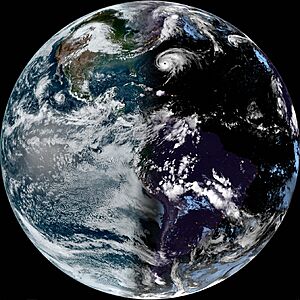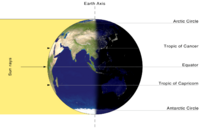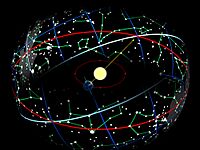Equinox facts for kids
An equinox is a special moment that happens twice a year when the Sun shines directly over the Earth's Equator. On the day of an equinox, the Sun appears to rise exactly in the east and set exactly in the west. These events happen each year around March 20 and September 23.
The word "equinox" comes from the Latin words aequus (equal) and nox (night). This is because on the day of an equinox, daytime and nighttime are almost equal in length everywhere on Earth. They aren't perfectly equal, but they are very close.
The equinoxes mark the beginning of new seasons. In the Northern Hemisphere, the March equinox is the start of spring, while the September equinox is the start of autumn. In the Southern Hemisphere, it's the other way around. Throughout the year, equinoxes alternate with solstices, which are the longest and shortest days of the year.
Contents
What Causes an Equinox?
The reason we have equinoxes and seasons is because of the way the Earth is tilted.
Earth's Tilted Axis
Imagine a line running through the Earth from the North Pole to the South Pole. This is Earth's axis, and it's the line our planet spins around. However, this axis isn't straight up and down compared to our path around the Sun. Instead, it's tilted at an angle.
Because of this tilt, as Earth orbits the Sun, different parts of the planet get more direct sunlight. When the Northern Hemisphere is tilted toward the Sun, it gets more direct light and experiences summer. When it's tilted away, it gets less direct light and has winter.
A Moment of Balance
An equinox happens at the two points in Earth's orbit where the tilt is sideways to the Sun. At this moment, the tilt is neither toward the Sun nor away from it. The Sun's light shines evenly on both the Northern and Southern Hemispheres.
This is the only time when the "terminator"—the line separating day and night—is a straight line that runs from the North Pole to the South Pole. Because the sunlight is spread out so evenly, the length of day and night is nearly the same all over the world.
-
From Earth, the Sun seems to travel along a path called the ecliptic (red line). The equinox happens when this path crosses the celestial equator (white line).
-
A diagram of Earth's seasons as seen from the north. The equinoxes happen between the solstices.
When Do Equinoxes Happen?
Equinoxes are important markers for our seasons and calendars.
Spring and Autumn Equinoxes
There are two equinoxes each year:
- The March Equinox happens around March 20. In the Northern Hemisphere, this is called the spring or vernal equinox, and it marks the start of spring. In the Southern Hemisphere, it's the autumnal equinox and marks the start of autumn.
- The September Equinox happens around September 23. In the Northern Hemisphere, this is the autumnal or fall equinox, marking the start of autumn. In the Southern Hemisphere, it's the spring equinox.
Why the Dates Can Change
The date of an equinox isn't always the same. It can vary slightly because our calendar system isn't a perfect match for Earth's orbit. A year on Earth is about 365.25 days long. We use leap years to help our calendar catch up, which can cause the date of the equinox to shift by a day or two.
Long ago, calendars like the Julian calendar weren't as accurate. The date of the spring equinox slowly shifted earlier over hundreds of years. To fix this, the modern Gregorian calendar was created. It has a better leap year rule that keeps the equinoxes happening around the same dates each year.
Why Day and Night Aren't Exactly Equal
Even though "equinox" means "equal night," the day and night on an equinox are not exactly 12 hours long. The day is usually a few minutes longer. There are two main reasons for this.
- The Sun is a Disc, Not a Point: Sunrise is defined as the moment the top edge of the Sun appears over the horizon, not its center. The same is true for sunset. This means we get a few extra minutes of daylight in the morning and evening.
- Earth's Atmosphere Bends Light: Our planet's atmosphere acts like a lens and bends sunlight. This effect, called atmospheric refraction, allows us to see the Sun's light even when it is technically just below the horizon.
The day when day and night are truly closest to being equal is called an equilux. This usually happens a few days before the spring equinox and a few days after the autumn equinox.
Equinoxes Around the World
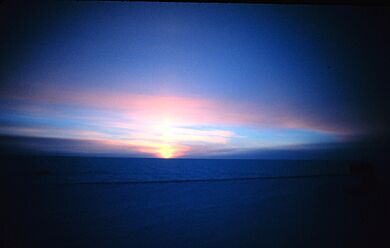
A View from the Poles
The equinoxes are very dramatic at the North and South Poles. At the North Pole, the March equinox marks the end of six months of darkness as the Sun rises for the first time. The Sun will then stay in the sky for the next six months. At the South Pole, the opposite happens: the Sun sets for the first time in six months.
On the day of the equinox, an observer at either pole would see the Sun skim across the horizon for 24 hours, never fully rising or setting.
Cultural Celebrations
For thousands of years, people have used the equinoxes to mark time and celebrate. Many cultures see the spring equinox as a time of rebirth and new beginnings.
- Nowruz, the Persian New Year, is celebrated on the March equinox in countries like Iran and Afghanistan. It is a festival that celebrates the start of spring.
- Many ancient structures were built to align with the Sun on the equinoxes. For example, at Angkor Wat in Cambodia, the Sun rises directly over the main temple on the spring equinox.
- In Japan, the days of the spring and autumn equinoxes are public holidays for people to spend time with family.
Equinoxes on Other Planets
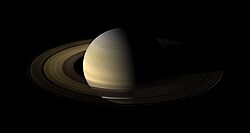
Any planet with a tilted axis has seasons and equinoxes, just like Earth.
A great example is Saturn. Saturn is tilted, and its famous rings orbit around its equator. During Saturn's equinox, which happens about once every 15 years, the rings are tilted perfectly edge-on to the Sun. From far away, they receive so little sunlight that they almost seem to disappear, leaving only a thin, dark line. Saturn's most recent equinox was on May 6, 2025.
Mars also has equinoxes. Its most recent ones were in December 2022 (northern spring) and January 2024 (northern autumn).
How Equinoxes Affect Satellites
The equinoxes can cause some interesting effects for the communications satellites that orbit Earth.
For a few days around each equinox, the Sun passes directly behind geostationary satellites (from our point of view on the ground). The Sun is so powerful that its energy can overwhelm the satellite's signals. This can briefly disrupt services like TV, radio, and internet. This event is called a sun outage.
Also, during an equinox, satellites in orbit above the Equator pass through Earth's shadow for the longest amount of time. When they are in the shadow, they can't use their solar panels and must rely on batteries for power.
Different Names for Equinoxes
You might hear equinoxes called by different names:
- Vernal equinox and autumnal equinox: These are older names. "Vernal" means spring, and "autumnal" means autumn. However, these names can be confusing because when it's spring in the northern half of the world, it's autumn in the southern half!
- March equinox and September equinox: These names are simpler because they just refer to the month they happen in. This avoids confusion about seasons in different parts of the world.
- Northward equinox and southward equinox: These names describe the direction the Sun appears to be moving. The northward equinox (in March) is when the Sun crosses the equator moving north. The southward equinox (in September) is when the Sun crosses the equator moving south. These terms are also useful for talking about other planets!
Related pages
Images for kids
See also
 In Spanish: Equinoccio para niños
In Spanish: Equinoccio para niños
- Analemma
- Anjana (Cantabrian mythology) – fairies believed to appear on the spring equinox
- Angkor Wat Equinox
- Aphelion – occurs around 5 July (see formula)
- Geocentric view of the seasons
- Iranian calendars
- Kōreisai – days of worship in Japan that began in 1878
- Lady Day
- Nowruz
- Orientation of churches
- Perihelion and aphelion
- Solstice
- Songkran
- Sun outage – a satellite phenomenon that occurs around the time of an equinox
- Tekufah
- Wheel of the Year
- Zoroastrian calendar


